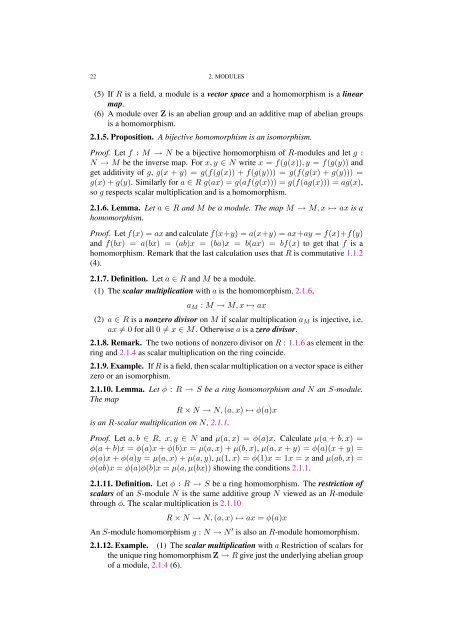Commutative algebra - Department of Mathematical Sciences - old ...
Commutative algebra - Department of Mathematical Sciences - old ...
Commutative algebra - Department of Mathematical Sciences - old ...
Create successful ePaper yourself
Turn your PDF publications into a flip-book with our unique Google optimized e-Paper software.
22 2. MODULES<br />
(5) If R is a field, a module is a vector space and a homomorphism is a linear<br />
map.<br />
(6) A module over Z is an abelian group and an additive map <strong>of</strong> abelian groups<br />
is a homomorphism.<br />
2.1.5. Proposition. A bijective homomorphism is an isomorphism.<br />
Pro<strong>of</strong>. Let f : M → N be a bijective homomorphism <strong>of</strong> R-modules and let g :<br />
N → M be the inverse map. For x, y ∈ N write x = f(g(x)), y = f(g(y)) and<br />
get additivity <strong>of</strong> g, g(x + y) = g(f(g(x)) + f(g(y))) = g(f(g(x) + g(y))) =<br />
g(x) + g(y). Similarly for a ∈ R g(ax) = g(af(g(x))) = g(f(ag(x))) = ag(x),<br />
so g respects scalar multiplication and is a homomorphism.<br />
2.1.6. Lemma. Let a ∈ R and M be a module. The map M → M, x ↦→ ax is a<br />
homomorphism.<br />
Pro<strong>of</strong>. Let f(x) = ax and calculate f(x+y) = a(x+y) = ax+ay = f(x)+f(y)<br />
and f(bx) = a(bx) = (ab)x = (ba)x = b(ax) = bf(x) to get that f is a<br />
homomorphism. Remark that the last calculation uses that R is commutative 1.1.2<br />
(4).<br />
2.1.7. Definition. Let a ∈ R and M be a module.<br />
(1) The scalar multiplication with a is the homomorphism, 2.1.6,<br />
aM : M → M, x ↦→ ax<br />
(2) a ∈ R is a nonzero divisor on M if scalar multiplication aM is injective, i.e.<br />
ax = 0 for all 0 = x ∈ M. Otherwise a is a zero divisor.<br />
2.1.8. Remark. The two notions <strong>of</strong> nonzero divisor on R : 1.1.6 as element in the<br />
ring and 2.1.4 as scalar multiplication on the ring coincide.<br />
2.1.9. Example. If R is a field, then scalar multiplication on a vector space is either<br />
zero or an isomorphism.<br />
2.1.10. Lemma. Let φ : R → S be a ring homomorphism and N an S-module.<br />
The map<br />
R × N → N, (a, x) ↦→ φ(a)x<br />
is an R-scalar multiplication on N, 2.1.1.<br />
Pro<strong>of</strong>. Let a, b ∈ R, x, y ∈ N and µ(a, x) = φ(a)x. Calculate µ(a + b, x) =<br />
φ(a + b)x = φ(a)x + φ(b)x = µ(a, x) + µ(b, x), µ(a, x + y) = φ(a)(x + y) =<br />
φ(a)x + φ(a)y = µ(a, x) + µ(a, y), µ(1, x) = φ(1)x = 1x = x and µ(ab, x) =<br />
φ(ab)x = φ(a)φ(b)x = µ(a, µ(bx)) showing the conditions 2.1.1.<br />
2.1.11. Definition. Let φ : R → S be a ring homomorphism. The restriction <strong>of</strong><br />
scalars <strong>of</strong> an S-module N is the same additive group N viewed as an R-module<br />
through φ. The scalar multiplication is 2.1.10<br />
R × N → N, (a, x) ↦→ ax = φ(a)x<br />
An S-module homomorphism g : N → N ′ is also an R-module homomorphism.<br />
2.1.12. Example. (1) The scalar multiplication with a Restriction <strong>of</strong> scalars for<br />
the unique ring homomorphism Z → R give just the underlying abelian group<br />
<strong>of</strong> a module, 2.1.4 (6).
















